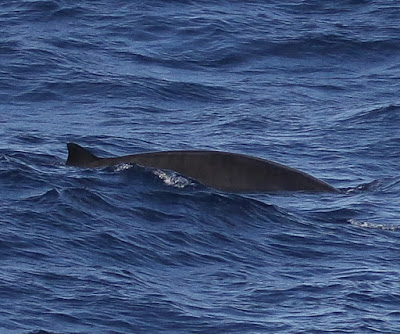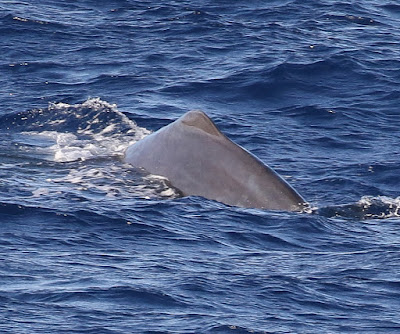As we cruised along the deep water channel between the Canary Islands, we had views of El Hierro & La Plama to our port & La Gomera & Tenerife to our starboard. The morning had got off to a good start with some Bryde's Whales & Short-finned Pilot Whales as an aperitif to breakfast. Additionally, there were good numbers of Cory's Shearwaters & a few other Seabirds, compared to the previous couple of days when we had been travelling through the deep oceans. The rest of the morning had been quiet for Cetaceans. Finally, in the early afternoon, my time on deck was rewarded when a pod of Striped Dolphins raced past going the other way.
During the afternoon, Bob Flood was lined up to give a talk on Pterodrama Petrel identification in the North Atlantic. It was a difficult decision about staying on deck given there was a fair bit of activity or attend what would have been an excellent talk. Had the talk been while we were in the deep oceans, then I would have attended the talk. But given we were close to steeply sloping seabed & land, I decided to stay on deck. Fortunately, the Cetaceans kept up the interest. Firstly, there was another pod of at least thirty Atlantic Spotted Dolphins.
Atlantic Spotted Dolphin
During the afternoon, Bob Flood was lined up to give a talk on Pterodrama Petrel identification in the North Atlantic. It was a difficult decision about staying on deck given there was a fair bit of activity or attend what would have been an excellent talk. Had the talk been while we were in the deep oceans, then I would have attended the talk. But given we were close to steeply sloping seabed & land, I decided to stay on deck. Fortunately, the Cetaceans kept up the interest. Firstly, there was another pod of at least thirty Atlantic Spotted Dolphins.
Finally, in late afternoon, there was a shout for a Beaked Whale close to the bows on the starboard side. I was on the port bridge wing, but had the opportunity to get some photos before it started to move down the starboard side.
Gervais's Beaked Whale: With many of the Beaked Whales it is important to see the head & beak shape so to see that on the first photos is good news
Gervais's Beaked Whale: A close crop of the head. This confirms that the jaw shape does not turn up, which rules out Blainville's Beaked Whale & True's Beaked Whale. Sowerby's Beaked Whale can be ruled out as they have a longer, thinner beak & a more prominent bulge on the forehead. Cuvier's Beaked Whale have a really stubby beak & the colouration is also wrong for this species. Finally, Northern Bottlenose Whales have a completely different beak & head shape. This just leaves Gervais' Beaked Whale as the last option in range & fortunately, the head, beak & jaw shape all fit for Gervais's Beaked Whales
Gervais's Beaked Whale: A close crop of the head. This confirms that the jaw shape does not turn up, which rules out Blainville's Beaked Whale & True's Beaked Whale. Sowerby's Beaked Whale can be ruled out as they have a longer, thinner beak & a more prominent bulge on the forehead. Cuvier's Beaked Whale have a really stubby beak & the colouration is also wrong for this species. Finally, Northern Bottlenose Whales have a completely different beak & head shape. This just leaves Gervais' Beaked Whale as the last option in range & fortunately, the head, beak & jaw shape all fit for Gervais's Beaked Whales
Gervais's Beaked Whale: Some Gervais's Beaked Whales show wiggly dark stripes on the back which is just visible on this photo
Gervais's Beaked Whale: I can see a few wiggly dark stripes in front of the dorsal fin on this photo
Gervais's Beaked Whale: Going down & more importantly I'm running out of opportunity to lean right from the port bridge wing & photograph it. Time to move as fast as possible to the starboard side
Many of the least known Cetaceans are Beaked Whales. They do not have obvious blows like the large Whales, do not linger on the surface for long periods of time like the Pilot Whales or regularly jump of out the water like the Dolphins. Additionally, many are a dull grey or brown & do not stand out, especially when the light makes the seas look grey. A number of the Beaked Whales species are thought to dive deep to hunt Squid & so they will spend a fair bit of time underwater. Finally, with the exception of three Northern Bottlenose Whales that I've seen from land, all the Beaked Whales that I've seen have moved straight past the ships I've been on, without taking any interest in the ships. With this air of mystery, then they are generally the group of Cetaceans I want to see the most.
Gervais's Beaked Whale: I reached the starboard side to find one was very close. But it would be very hard to identify it as it wasn't possible to see much on the head or dorsal fin
Gervais's Beaked Whale: The third Gervais's Beaked Whale appeared (in the bottom right). The other two are top left, albeit one had already slipped below the water
It was the start of Happy Hour in the Observation lounge & a number of people were below decks when the Gervais's Beaked Whales came through. However, they had a second chance a couple of hours later when there was another Gervais Beaked Whale sighting.
Gervais's Beaked Whale: Other people's photos also confirmed this was a Gervais's Beaked Whale, although my photos don't. It clearly has an odd dorsal fin shape
In early evening, there was final Atlantic Spotted Dolphin pod that briefly appeared by the Plancius, to put on a final show for those still on deck.
Atlantic Spotted Dolphin: Sub adult. This was the only individual I managed to photograph in this pod
Atlantic Spotted Dolphin: Sub adult. The white tip to the beak & the grey & pale markings indicates this is a sub adult Atlantic Spotted Dolphin. Note, most of the pale spots are probably water droplets rather than markings
I had spent another twelve hours or so on deck, but it had been rewarding.























